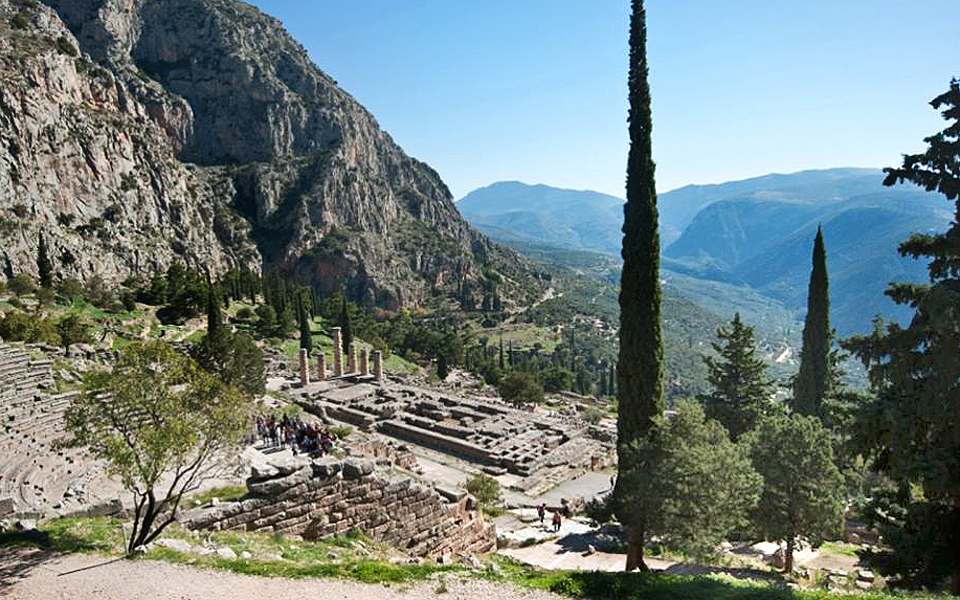Despite all of Greece’s problems last year, the archaeological site of Delphi still attracted 500,000 visitors, who flocked to the foot of Mount Parnassus, where the most famous oracle of ancient Greece once operated. It always placed high on the itinerary list of many foreign visitors but was not always so easy to access– Many monuments scattered haphazardly, steep slopes and an inadequate infrastructure.
Delphi did not benefit from extra community funds and enhancement projects. The one exception was the restoration of the Athenian Treasure in 2004. But for those who made it as far as the temple, it was clear that there had been no comprehensive plan in place for years.
However, a new visit finds the landscape with several welcome changes. Neatly kept sites, well formed paths, clear boundaries around the monuments and new green areas. The thick ivy that covered the retaining walls discovered during the French Excavation (1892-1902) has been uprooted, branches trimmed, nearly 200 sick or dead trees cut down, and laurels, myrtles, oaks, olive trees, arbutus and rosemary added in their place.
Within two years and with limited staff, the Ephorate of Fokida Antiquities has worked wonders. Access to Delphi for disabled people is no longer the perilous undertaking it was before, while the visually impaired now also have access to information.
Under the project titled “Study Delphi Archaeological Area”, –integrated into the Regional Operational Program of Thessaly, Central Greece and Epirus 2007-2013– eight archaeologists, conservators, architects and 18 craftsmen arrived on the site with a budget of €600,000.
What does this change?
“It adds value”, says the archaeologist Athanasia Psalti, Head of the Ephorate of Fokida Antiquities, noting that parts of the sanctuary were a shambles and that within this two year period an attempt was made to recover the original form of the monuments that had not been restored in previous excavations. “The monuments are now recognizable and understandable.”
“We made the site cleaner for the visitor. We also placed signs in Braille, a move with symbolic benefits for the protection and enhancement of the archaeological site of Delphi.”
The gravel roads were also covered to make access for people using wheelchairs easier, and grooves constructed for the drainage of rainwater, as well as some 500 architectural features identified and recorded.
The Ancient Roman forum colonnade also underwent restoration with masonry repaired and the addition of a layer of fine sand..
The southern part of the Sacred Way, which until 2013 consisted of scattered pieces, can now be admired in a neatly kept environment with restored pedestals. For the first time, the Sanctuary of Asclepius has been made accessible and, after cleaning, the source of the Sacred Castalian Spring now runs again.
At the Temple of Apollo, 20 architectural items and inscriptions were uncovered. At the Stoa of the Athenians, preservation work was carried out on the surface of seven columns and its inscriptions while at the Tholos of Delphi, 250 components of the site have been arranged so as not to obstruct access as they previously did, while rocks from a 1905 landslide have also been removed.
One of Delphi’s most iconic symbols is the Serpent Column monument, part of a sacrificial tripod dedicated to Apollo after the Greek victory over the Persians at the battle of Plataea. This is a copper column measuring 7.5 meters in length and shaped in the form of three snakes.
The gold tripod was melted by the Phocians in the 4th century to mint coins while, in 330 AD, the copper column itself was removed to Constantinople by Constantine I.
In its place, a bronze copy was erected as a symbol of what a united people can achieve. This message forms part of the excellent educational program offered on the occasion of the completion of the enhancement project.
The next step is expected to be the restoration of the 5,000- capacity ancient theater of Delphi, bombed in World War II, which is included in a national program for central Greece and expected to begin soon.
“The main objective is the maintenance of all the works done and the completion of studies into the restoration sites.” says Psalti, who notes that the last restoration at Delphi took place in the 1930s.











